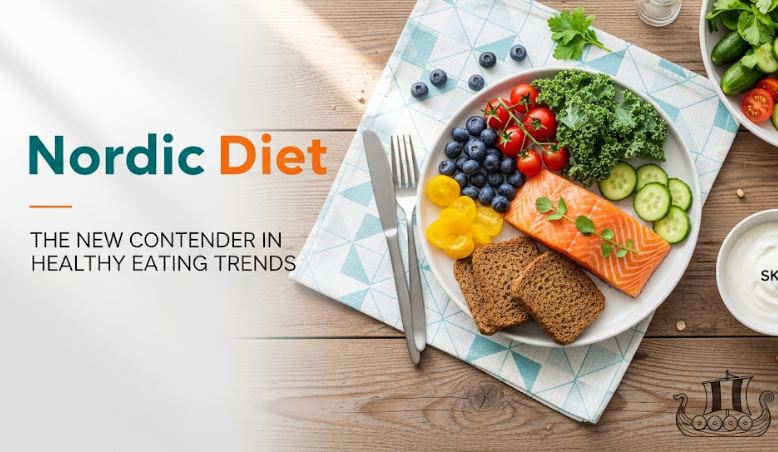Nordic Diet – The New Contender in Healthy Eating Trends

In the ever-evolving world of nutrition and diets, the Nordic Diet has quietly but steadily gained momentum as a serious contender to the well-established Mediterranean Diet. While the Mediterranean Diet has been praised for decades, the Nordic Diet is now stepping into the spotlight, promising health benefits backed by science and a distinctly northern flavor profile.
If you’re curious about how the Nordic Diet compares, what makes it unique, and why it might just be your next healthy lifestyle move, this blog has you covered.
🌿 What is the Nordic Diet?
Originating from the countries of Denmark, Sweden, Norway, Finland, and Iceland, the Nordic Diet is inspired by traditional eating patterns in these regions. It emphasizes:
- Seasonal, locally sourced foods
- Whole grains like rye, barley, and oats
- Plenty of vegetables and fruits, especially root vegetables and berries
- Fatty fish such as salmon, herring, and mackerel
- Legumes and nuts
- Moderate dairy consumption, preferably fermented products like yogurt and skyr
- Limited red meat and processed foods
Unlike trendy fad diets, the Nordic Diet encourages sustainable eating and celebrates the natural flavors of fresh, minimally processed foods.
🍽️ How Does It Compare to the Mediterranean Diet?
Both the Nordic and Mediterranean diets focus on whole, plant-based foods and healthy fats, but there are some key differences:
- Fat sources: The Mediterranean Diet is famous for its olive oil; the Nordic Diet favors rapeseed (canola) oil, which has a favorable omega-3 to omega-6 ratio.
- Grains: Mediterranean eating includes wheat, couscous, and rice, while Nordic focuses on rye, barley, and oats, grains well-suited to colder climates.
- Protein: Both prioritize fish, but Nordic cuisine includes more fatty fish varieties native to northern seas. Red meat is limited in both but slightly more consumed in Nordic traditions due to farming practices.
- Dairy: Mediterranean diets typically have low to moderate cheese and yogurt, while the Nordic Diet includes fermented dairy like skyr, which is high in protein and probiotics.
Both diets are heart-healthy and promote longevity, but the Nordic Diet’s emphasis on seasonality and sustainability is strikingly modern and eco-conscious.
🩺 Health Benefits Backed by Science
The Nordic Diet isn’t just trendy; it’s supported by scientific research. Studies show it can:
- Reduce inflammation and improve markers of heart health
- Help with weight management and fat loss
- Lower the risk of type 2 diabetes
- Improve gut health thanks to its fiber-rich grains and fermented dairy
- Promote mental well-being through nutrient-dense, antioxidant-rich foods like berries and fatty fish
Many clinical trials have noted improvements in blood pressure and cholesterol levels among participants following the Nordic Diet, positioning it as a serious diet for cardiovascular protection.
🥕 What Makes the Nordic Diet Stand Out Today?
1. Seasonality & Sustainability
Unlike many diets that rely on imported superfoods, the Nordic Diet encourages eating what’s grown locally and in season. This reduces carbon footprint and supports local farmers, aligning perfectly with rising consumer interest in sustainable eating.
2. Flavor & Simplicity
Nordic cuisine uses simple preparations that highlight natural flavors — think roasted root vegetables, pickled herring, and fresh rye bread. The diet doesn’t require exotic ingredients or complicated recipes, making it accessible and enjoyable.
3. Mental & Emotional Connection
The Nordic countries promote “hygge”, a lifestyle concept emphasizing coziness and mindfulness. The Nordic Diet complements this by encouraging mindful eating and connection with nature’s rhythms, which is a refreshing antidote to fast-food culture.
🥇 Trending or Here to Stay?
While the Mediterranean Diet has enjoyed decades of spotlight, the Nordic Diet is rising fast in popularity, especially in northern Europe and among eco-conscious consumers worldwide.
Its focus on:
- Real, unprocessed foods
- Environmentally friendly choices
- Balanced nutrition with room for indulgence
makes it ideal for the future of sustainable health.
On social media platforms like Instagram and TikTok, hashtags like #NordicDiet and #EatNordic are trending, with food bloggers sharing rustic recipes featuring lingonberries, pickled vegetables, and smoked salmon.
🔄 Can You Mix the Best of Both Worlds?
Absolutely! Many nutritionists suggest combining the Mediterranean and Nordic principles to customize a diet that fits your tastes and environment.
- Use olive and rapeseed oils interchangeably for healthy fats
- Include a variety of whole grains from both traditions
- Enjoy seasonal fruits and vegetables local to your region
- Prioritize fatty fish and fermented dairy for gut and heart health
This hybrid approach can maximize health benefits while keeping your palate interested.
🍽️ How to Start the Nordic Diet Today
- Shop local and seasonal — focus on root veggies, berries, and whole grains
- Incorporate fatty fish 2-3 times a week (salmon, mackerel, herring)
- Use rapeseed oil instead of butter or processed oils
- Try fermented dairy like skyr or plain yogurt
- Minimize processed meats and refined carbs
- Embrace simple cooking methods like roasting, pickling, and steaming
🧠 Final Thoughts: The Nordic Diet Is More Than a Trend — It’s a Lifestyle
The Nordic Diet is emerging as a powerful, sustainable alternative to traditional healthy eating plans. With its focus on local, whole foods and a philosophy rooted in simplicity and seasonality, it’s perfect for anyone looking to improve health without sacrificing taste or values.
If you want a diet that combines science-backed benefits, environmental awareness, and cozy comfort, the Nordic Diet deserves a serious look.




